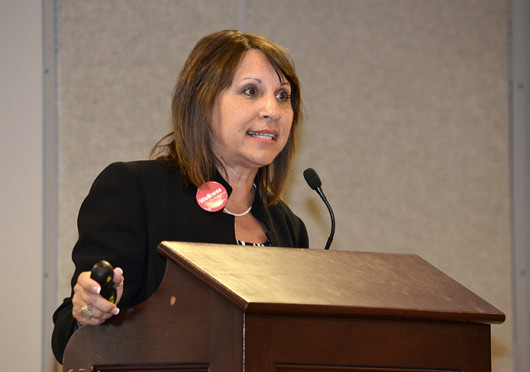
Bernadette Melnyk, dean of the College of Nursing, speaks at the State of Health and Wellness in Buckeye Nation Oct. 14 at the Ohio Union.
Credit: Courtesy of Sanford Meisel, College of Nursing
Some leaders of health and wellness at Ohio State want to make the university the healthiest in the nation, but they don’t think it’s all on them — it starts on a personal level.
“It doesn’t work from a top down approach,” said Bernadette Melnyk, associate vice president for health promotion, university chief wellness officer and dean of the College of Nursing. “You have to have people at a grassroots (level) who are helping us to create environments and cultures of wellness.”
The annual address on the State of Health and Wellness in Buckeye Nation, held Monday at Ohio Union and led by Melnyk, focused on inspiring faculty members to have a positive attitude toward health and wellness and included a discussion about ways to improve their overall personal wellness.
“I want people to get inspired and motivated to make healthy lifestyle behavior changes,” Melnyk said in an interview with The Lantern after the address.
About 200 people attended the address, which included lunch. The event cost approximately $5,500 and was paid for by the College of Nursing, according to Kathryn Kelley, the chief advancement officer of the College of Nursing.
Melnyk first addressed some findings from a report of more than 28,000 faculty members’ Personal Health and Well-Being Assessments. The assessments combine self-reported information about the participant’s health along with information from biometric health screenings, which are screenings of a patient’s overall health through measures like blood pressure or body mass index, a measure of body fat based on height and weight. Melnyk said this type of information can help wellness leaders determine where the university is in terms of health and plan desired outcomes accordingly.
Faculty and staff members who do not complete a PHA only have access to two basic health care plans, which cost upwards of about $95 per month, instead of having four options that cost upwards of $34 per month, according to the OSU My Benefits Plan 2014 website.
Melnyk said according to the assessments, about 61 percent of the faculty and staff are overweight or obese and about 25 percent reported their total cholesterol levels are more than 200.
Cholesterol levels between 200 to 239 are considered borderline high and those above 240 are considered high, which can lead to an increased risk of heart attacks and strokes, according to the American Heart Association website.
Melnyk said these levels are “not a whole lot better” than the national average, which is about 200, according to the Centers for Disease Control and Prevention.
“We have a lot of room for opportunity,” she said.
Larry Lewellen, vice president of care coordination and health promotion, said OSU needs to work on constant improvement.
“We’ve got to be more healthier next year than this year, and healthier still the following year,” he said in his speech at the event.
Melnyk emphasized the importance of engaging in four key behaviors for personal health and wellness: not smoking, participating in at least 30 minutes of physical activity five times a week, eating healthier by consuming five fruits and vegetables a day and drinking alcohol in moderation.
In her address, she also challenged faculty to develop new, innovative ways to increase health and wellness, adding it is important to find ways to make being healthy enjoyable.
Melnyk said this year wellness leaders will specially be focused on nutrition and physical activity.
Those working on health initiatives are also going to keep promoting initiatives and groups that were effective in the past, such as the Buckeye Wellness Amazing Race, an on-campus wellness event based on CBS’ reality show “The Amazing Race” that was held Aug. 28, and the Buckeye Wellness Innovators program, a group of faculty and staff members who promote and plan their own health and wellness activities in their respective departments. Winners from this year’s Amazing Race competition and the Buckeye Wellness Innovators who were deemed the most successful were recognized and given awards at Monday’s address.
Michelle Fennessy, an assistant professor in the College of Nursing, said she attended the address because she believes in order to promote health and wellness in her profession, she needs to be healthy herself and she wanted to learn how the university would help. She said she felt the address emphasized the importance of individual participation.
“Even though it’s a university initiative, each of us as an individual has a part,” Fennessy said.
Melnyk said she hoped faculty members who attended took at least one important message from her address.
“I hope they’re inspired to make one healthy lifestyle change, whatever that is for them. Just one,” Melnyk said. “That’s the simple message I (wanted) to get out.”


